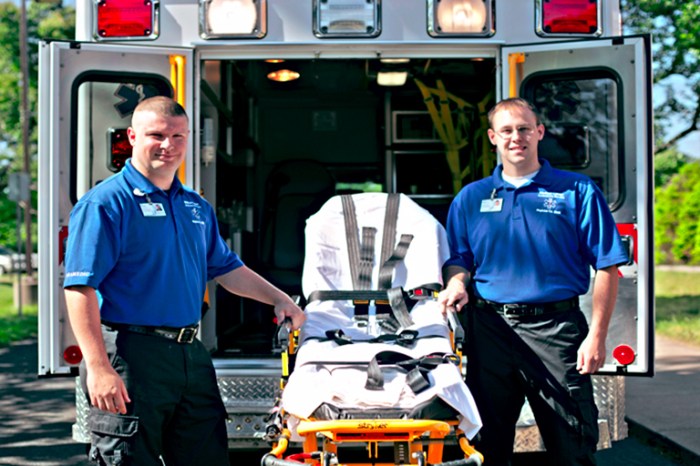Emergency medical services (EMS) play a vital role in our healthcare system, providing life-saving care to those in need. From responding to accidents and emergencies to providing transport to medical facilities, EMS professionals are on the frontlines of healthcare, ensuring that patients receive the timely and efficient care they need.
EMS providers include emergency medical technicians (EMTs) and paramedics, who are trained to assess and treat patients in the field. They use a variety of medical equipment and technology to provide care, including defibrillators, oxygen tanks, and IV fluids. EMS agencies are typically organized into local or regional systems, and they work closely with other healthcare providers to ensure a seamless continuum of care for patients.
Overview of Emergency Medical Services (EMS)

Emergency Medical Services (EMS) is a system of coordinated healthcare services that provides medical care and transportation to individuals experiencing a medical emergency or trauma. EMS encompasses a range of services, including emergency response, assessment, stabilization, and transportation to definitive care facilities.EMS providers are trained to provide pre-hospital care, including basic life support (BLS), advanced life support (ALS), and specialized care for various medical emergencies.
These providers work in collaboration with emergency medical dispatchers, who receive and triage emergency calls and dispatch appropriate resources.EMS plays a crucial role in the healthcare system by providing timely and life-saving interventions during medical emergencies. EMS providers work closely with other healthcare professionals, such as physicians, nurses, and hospital staff, to ensure a seamless transition of care for patients.
Types of EMS Providers
EMS providers are classified into different levels based on their training and scope of practice. The primary categories include:
Emergency Medical Technicians (EMTs)
EMTs provide basic life support (BLS), including CPR, oxygen administration, and wound care.
Advanced Emergency Medical Technicians (AEMTs)
AEMTs provide advanced life support (ALS), including intubation, medication administration, and cardiac monitoring.
Paramedics
Paramedics provide the highest level of pre-hospital care, including ALS, trauma management, and specialized interventions such as defibrillation and medication administration.The level of EMS provider dispatched to an emergency scene is determined by the nature and severity of the medical condition.
EMS Operations
EMS operations involve a comprehensive system of dispatching, assessing, and treating patients in emergency situations. This critical service plays a vital role in providing timely and efficient medical assistance to those in need.
The dispatch process begins with a call to an emergency number, such as 911 or 112. Trained dispatchers gather essential information about the patient’s condition, location, and any immediate hazards. Based on this information, the dispatcher determines the appropriate response level and dispatches the nearest available EMS crew.
Assessing and Treating Patients in the Field
Upon arriving at the scene, EMS crews conduct a thorough assessment of the patient’s condition. This includes taking vital signs, examining for injuries, and gathering information about the patient’s medical history. Based on the assessment, EMS providers determine the appropriate course of treatment and administer necessary medications or interventions.
In cases of life-threatening emergencies, such as cardiac arrest or severe trauma, EMS crews are equipped with advanced life support equipment and trained to perform life-saving procedures, including CPR, defibrillation, and airway management.
Use of Medical Equipment and Technology in EMS
Modern EMS operations rely heavily on advanced medical equipment and technology to enhance patient care. These include:
- Vital signs monitors:Track heart rate, blood pressure, oxygen saturation, and other vital parameters.
- Defibrillators:Used to deliver electrical shocks to restore normal heart rhythm in cases of cardiac arrest.
- Ventilators:Provide mechanical assistance with breathing for patients with respiratory distress.
- Patient monitors:Wireless devices that transmit patient data to the hospital in real-time, enabling remote monitoring and early intervention.
- Mobile data terminals:Allow EMS crews to access patient records, consult with medical professionals, and navigate to emergency scenes.
EMS Management
Emergency Medical Services (EMS) agencies are responsible for providing emergency medical care to the public. They are typically organized into a hierarchical structure, with a director or chief at the top, followed by managers, supervisors, and line-level providers. The director or chief is responsible for the overall operation of the agency, including setting policies, procedures, and budgets.
Managers and supervisors are responsible for overseeing the work of line-level providers and ensuring that they are providing quality care. Line-level providers are the individuals who provide direct patient care.
Leadership in EMS
Leadership is essential in EMS. Effective leaders are able to motivate and inspire their staff, create a positive work environment, and make sound decisions in high-pressure situations. They are also able to build relationships with other agencies and organizations to ensure that EMS is integrated into the community’s emergency response system.
Challenges and Opportunities Facing EMS Management
EMS management faces a number of challenges, including:
- Increasing demand for services
- Shortage of qualified personnel
- Rising costs
- Changes in healthcare regulations
Despite these challenges, EMS management also has a number of opportunities to improve the quality of care and efficiency of operations. These include:
- Implementing new technologies
- Developing new partnerships
- Improving training and education
- Advocating for changes in healthcare regulations
EMS Education and Training: Emergency Medical Services
EMS providers require comprehensive education and training to effectively respond to medical emergencies. This training ensures they possess the knowledge, skills, and judgment to provide optimal patient care.
Levels of EMS Education and Training
EMS education and training are typically categorized into different levels, each with varying requirements and responsibilities:
- First Responder (FR):Provides basic life support (BLS) and first aid in emergency situations.
- Emergency Medical Technician (EMT):Provides more advanced BLS, including oxygen administration and automated external defibrillation (AED) use.
- Advanced Emergency Medical Technician (AEMT):Offers more advanced skills, such as intravenous (IV) therapy, medication administration, and advanced airway management.
- Paramedic:The highest level of EMS certification, providing comprehensive pre-hospital care, including advanced life support (ALS) and invasive procedures.
Continuing Education for EMS Providers
Continuing education is crucial for EMS providers to stay up-to-date with the latest advancements in emergency medical care. This includes attending conferences, workshops, and online courses to enhance their knowledge and skills.
Simulation and Technology in EMS Education, Emergency medical services
Simulation and technology play a significant role in EMS education. Simulators and virtual reality environments provide realistic scenarios that allow EMS students to practice their skills in a controlled setting. This enhances their decision-making abilities and prepares them for real-life emergencies.
EMS Research and Development

EMS research and development is crucial for advancing the field and improving patient care. It involves investigating new technologies, practices, and policies to enhance the efficiency and effectiveness of EMS systems.
Technology plays a vital role in EMS research, enabling the development of innovative devices and tools that improve patient monitoring, communication, and treatment. Data analysis techniques help researchers identify trends and patterns in EMS data, leading to evidence-based decision-making and improved patient outcomes.
Importance of Evidence-Based Practice in EMS
Evidence-based practice is essential in EMS, ensuring that decisions are made based on the best available scientific evidence. It involves systematically reviewing research findings, considering the validity and reliability of studies, and applying the results to improve patient care.
- Enhanced Patient Outcomes: Evidence-based practices have been shown to improve patient outcomes by reducing errors, increasing efficiency, and optimizing treatment strategies.
- Informed Decision-Making: By relying on scientific evidence, EMS providers can make informed decisions about patient care, ensuring that interventions are supported by research and best practices.
- Improved Resource Allocation: Evidence-based practice helps EMS systems allocate resources effectively, prioritizing interventions that have been proven to be most beneficial for patients.
EMS and Public Health
EMS plays a critical role in promoting public health by providing immediate medical attention to individuals in need, regardless of their ability to pay. EMS professionals are often the first responders to medical emergencies, and they can provide life-saving care that can help to prevent long-term health problems.In addition to providing emergency medical care, EMS can also be used to address health disparities.
For example, EMS can be used to provide transportation to medical appointments for individuals who do not have access to transportation, and it can also be used to provide health education and screenings to underserved communities.There are many opportunities for collaboration between EMS and public health agencies.
For example, EMS and public health agencies can work together to develop and implement programs that address the health needs of the community, and they can also work together to improve the quality of care that is provided to patients.
Role of EMS in Promoting Public Health
EMS plays a vital role in promoting public health by providing immediate medical attention to individuals in need. EMS professionals are often the first responders to medical emergencies, and they can provide life-saving care that can help to prevent long-term health problems.In addition to providing emergency medical care, EMS can also be used to address health disparities.
For example, EMS can be used to provide transportation to medical appointments for individuals who do not have access to transportation, and it can also be used to provide health education and screenings to underserved communities.
Opportunities for Collaboration between EMS and Public Health Agencies
There are many opportunities for collaboration between EMS and public health agencies. For example, EMS and public health agencies can work together to develop and implement programs that address the health needs of the community, and they can also work together to improve the quality of care that is provided to patients.One example of a successful collaboration between EMS and a public health agency is the “EMS-Public Health Partnership” in New York City.
This partnership has been in place since 2002, and it has helped to improve the quality of care that is provided to patients by EMS professionals. The partnership has also helped to increase the number of EMS professionals who are trained in public health.
Closing Summary

EMS is a dynamic and challenging field that is constantly evolving. As technology advances and new treatments are developed, EMS providers must stay up-to-date on the latest best practices to provide the best possible care to their patients. EMS is a vital part of our healthcare system, and it plays a critical role in saving lives and improving the health of our communities.
FAQ Section
What is the difference between an EMT and a paramedic?
EMTs are trained to provide basic life support, such as CPR and first aid. Paramedics are trained to provide advanced life support, such as administering medications and performing invasive procedures.
What is the scope of practice for EMS providers?
EMS providers are trained to assess and treat patients in the field, including providing basic and advanced life support. They can also transport patients to medical facilities and assist with other medical emergencies.
How can I become an EMS provider?
To become an EMS provider, you must complete an accredited training program and pass a state or national certification exam.